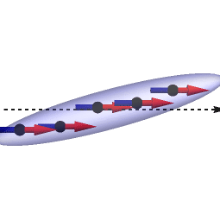In a new paper published in Physical Review Letters, we present experiments on droplets of a quantum liquid where we observe an oscillation called the “scissors mode”.
How do you probe the intrinsic properties of a liquid? One way is to measure its collective excitations. For instance Lord Rayleigh showed over a century ago that the shape of a drop of liquid can oscillate in time. The frequency of these oscillations depends on the value of the surface tension inherent to the liquid. Thus by probing the spectrum of these excitations, one can deduce this surface tension. Rayleigh’s liquid drop model has been also used in first approximation to describe liquids that are quantum in nature, namely liquid helium and atomic nuclei. In the latter however, another oscillation mode has been observed, falling outside Rayleigh’s model. This is an out-of-phase angular oscillation of the neutrons and protons, which has inspired its name: the scissors mode. Its existence is a marker of the presence of magnetic dipoles in the nuclei, which cause an intrinsic anisotropy.
In our work, we study a droplet of a quantum liquid made of magnetic dysprosium atoms, aligned along a homogeneous magnetic field. Thus, the interatomic dipole-dipole interactions intrinsic to the liquid break rotational invariance. Using a new spectroscopic probe based on modulating the direction of a magnetic field, we demonstrate the existence of a scissors mode. This both proves the strong anisotropy of this liquid, and provides a sensitive probe for its internal properties. A difference with nuclei is that only one type of atoms is present, the ‘scissors’ are thus composed of a single blade.


